The Liberal party has changed leader, in part because of climate change, and are now proceeding with pretty much the final policy landed upon by Malcolm Turnbull, with a couple of significant twists. We now have a very explicit instruction that energy prices along with keeping the lights on are the main game, while emissions reductions can be safely put off to the never-never.
The Coalition government under Scott Morrison is now almost completely isolated on energy and climate change. Compared to adult countries we look completely foolish, The question remains whether the main actors, the states and the corporates investing in the system, can move forward regardless.
The ABC, bless them, ran an opinion piece just after the putsch Climate change is World War III, and we are leaderless by Dr David Shearman who is the honorary secretary of Doctors for the Environment Australia and Emeritus Professor of Medicine at Adelaide University.
He takes his lead from environmental activist Bill McKibben, who has recently written, “World War III is well and truly underway. And we are losing”.
Shearman finds:
- Two of the world’s highest per capita carbon emitters, the United States and Australia, have deserted the trenches of WWIII by trading ideology for human lives and health.
Turnbull has done so with full knowledge of what he was doing when he chose political expediency over the future of humanity and the planet. Morrison has the excuse that he hasn’t paid attention to the debate.
So we have exchanged a knave for a fool.
Shearman concludes with a reference to his organisation’s report No time for games: Children’s health and climate change, with a foreword by Fiona Stanley, which I confess I had not seen.
After the putsch there was some exuberance about building coal-fired power stations, I’m told, on the front page of The Australian. However, industry players and business generally recoiled in horror at the spill, and now seem to be intent on putting the cue in the rack, waiting for an election. Many have taken a look at what Bill Shorten and Chris Bowen have to offer, and are not displeased.
Meanwhile, Fiona Simpson, CEO of the National Farmers Federation (NFF) has accepted the reality of human-caused climate change and called for appropriate planning, while a new study has forecast an intensification of weather associated with the El Niño/La Niña cycle. As Simpson said:
- “We are at the front line of climate change, increasingly erratic seasons, out-of-season rainfall or no rainfall at all and longer, hotter summers.”
It’s more than that, of course, including bleaching and acidification to the Great Barrier Reef, water scarcity for Sydney, our largest city, rising seas and storm surges.
The ABC suggested that I might also like to look at their 17 November piece on the launch of the Powering Past Coal Alliance, where 20 countries signed up to phase out coal power by 2030 at the UNFCCC Conference of Parties in Bonn last year. See the UNFCCC notice here, with a link to the formal statement of intent. Canada and the UK initiated the Alliance.
Part of the intent is to increase the membership of the Alliance beyond 20. The initial members were, in alphabetical order, Austria. Belgium, Britain, Canada, Costa Rica, Denmark, El Salvador, Fiji, Finland, France, Italy, Luxembourg, The Marshall Islands, Mexico, The Netherlands, New Zealand, Niue, Portugal, and Switzerland.
Of course some of those are tiddlers, and there has been criticism of the Germans, who were absent.
It seems the Germans have been working on setting up a coal exit commission tasked with formulating a plan by the end of this year as to how the exit will be managed. In fact Angela Merkel’s first attempt to form a coalition after the election last September with both the Greens and the Free Democratic Party (business-oriented free-market liberals) had foundered over this very issue. With the SPD (socialists) on board in a ‘grand coalition’, they still had several aborted attempts, but finally achieved the launch on 24 July 2018. There is a cast of thousands, almost, with a mix of stakeholders and people with knowhow including government, business, unions, NGOs etc.
Notice the presence of one Hans Joachim Schellnhuber, Director of the Potsdam Institute for Climate Impact Research (PIK) as one of the 24 extra members. Prof Schellnhuber used to be the leading light of the WBGU, the German Advisory Council for Global Change, which advises the German Government on climate change. The Council is made up of 10 members, all professors across a range of disciplines, with an appropriate gender balance of seven women and three men, meeting two days per month. Herr Prof Schellnhuber is the old guy at the end:
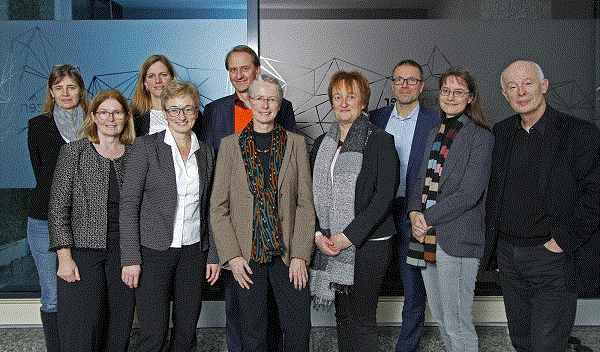
The German political system looks to science and reason for advice, seeing climate change in the broadest possible context, then involves the stakeholders, interested parties and those who can make a practical contribution in the implementation stage.
The ‘coal exit commission’, properly called the “Special Commission on Growth, Structural Economic Change and Employment”, is not so much a reaction to the Powering Past Coal Alliance, rather stemming out of Germany’s Climate Action Plan 2050, concluded in 2016 with the aim as making Germany “largely GHG emissions-neutral” by 2050. The Plan commits the new government:
-
to set up a “special commission on growth, structural economic change and employment,” bringing together policymakers, industry representatives, environmental organisations, labour unions, and affected federal states and regions to draft an action programme by the end of 2018, which should include:
- measures to close the action gap to achieve the 2020 climate goal “as much as possible,” and to make the 2030 energy sector goal “reliably achievable”
- a plan “for the gradual reduction and phase-out of coal-fired power production, including an end date, and the necessary accompanying legal, economic, social, and structural policy measures”
- financial support for the necessary structural changes in affected regions, and a fund financed through the federal budget
It’s more than a little embarrassing to come back home and look at these finger-pointing clowns who are ignoring climate change, and seeing energy in the narrowest possible context:
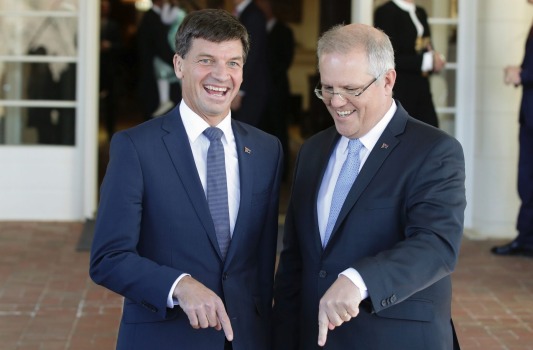
That was from Ben Potter in the AFR – Wholesale energy prices have spiked as government split over policy.
This would be funny if it were not serious, as David Rowe’s cartoon shows:
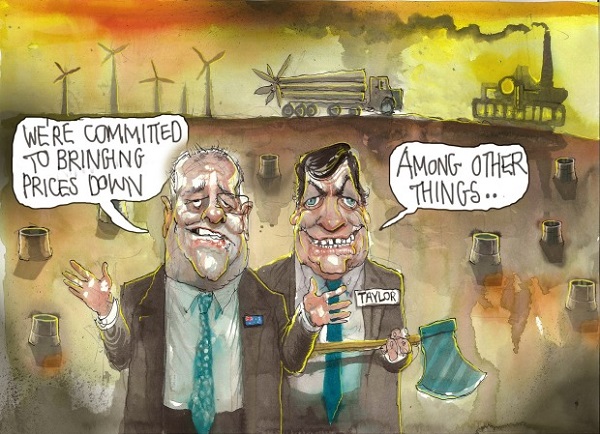
There is a price for this stupidity, as Potter in Renewables better than a big stick at cutting power prices warns:
- The clean energy lobby has warned the new federal energy minister Angus Taylor not to take wind and solar energy for granted because they are putting more downward pressure on wholesale electricity prices than the government’s market interventions.
Kane Thornton, chief executive of the Clean Energy Council, said Australia would face scrutiny at the COPS24 climate meeting in Poland in December if the government’s representatives turn up with no concrete policies for achieving the nation’s Paris carbon emissions reduction targets.
The world is watching.
There has been another price. Look at what happened to power price futures:
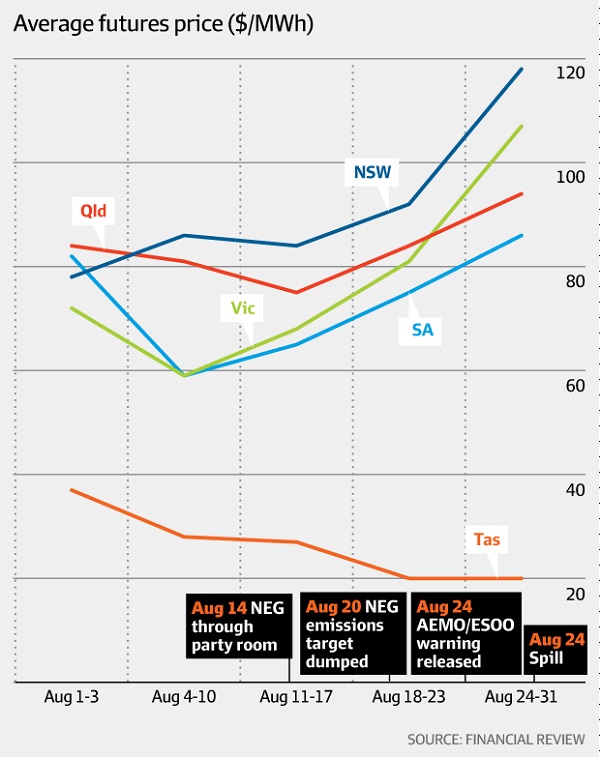
OK, there were a few other things going on:
-
The energy market has started to focus more on the challenges next summer may bring; drought has depleted Snowy Hydro’s storages and the Australian Energy Market Operator’s 2018 Electricity Statement of Opportunities, released on the eve of the leadership spill, said unreliable, ageing coal and gas plants will increase the risk of summer blackouts in the coming years if new capacity isn’t built to replace them in time.
Load shedding in NSW and Victoria on the Saturday after the spill after lightning felled the Queensland-NSW Interconnector also highlighted the vulnerability of the grid.
When the lightning struck, within 50 seconds the Heywood Interconnector between SA and Victoria also tripped. Then:
Some 60 megawatts of Snowy’s fast-start hydro capacity kicked in automatically within a few seconds, followed by another 150MW a few minutes later.
However, the incident showed the fragility of the system and there is more than prices to worry about. The robustness of the ‘gold-plated’ network, for example.
All that considered, however, the price spikes show that the system needs the future of energy generation to be taken seriously. The adults in the business know that means coal has to go.
Giles Parkinson says business has given up on Coalition, and is turning to Labor and states on energy and climate. So the energy players will sit out the months to the next election. Or will they?
Further on in the article Environment Victoria’s Erwin Jackson says:
-
“The idea has been floating around for a state-based NEG. People are thinking about the principles, and one of core ones remain durability.” That is what makes changing the rules of the market attractive in this case. It is impervious to Abbott and whoever succeeds in his role.
While Angus Taylor says there is too much wind and solar in the grid Queensland has set up the promised CleanCo, a third state-owned electricity generator focussing on renewables, with $250 million to spend. Queensland says wind and solar are the key to cheaper electricity.
However, business is heavily on board in Queensland. A Green Energy Markets report finds Queensland could be 90 per cent renewables by 2030. Take a look at these three graphs. First, this is what has happened since Labor came to power in 2015:
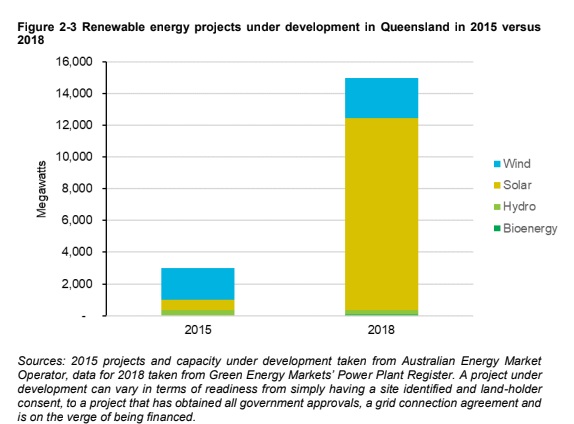
This is what is likely to happen by 2020:
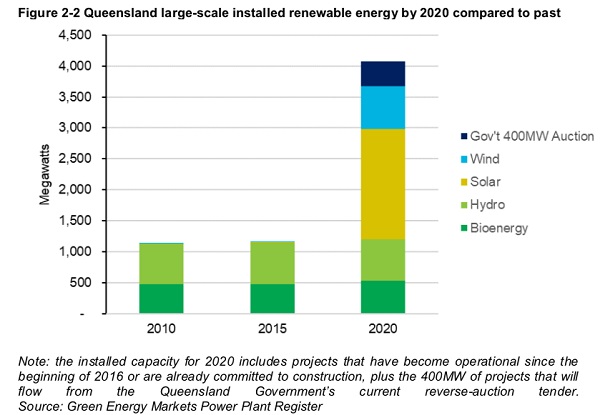
This is what could happen by 2030:
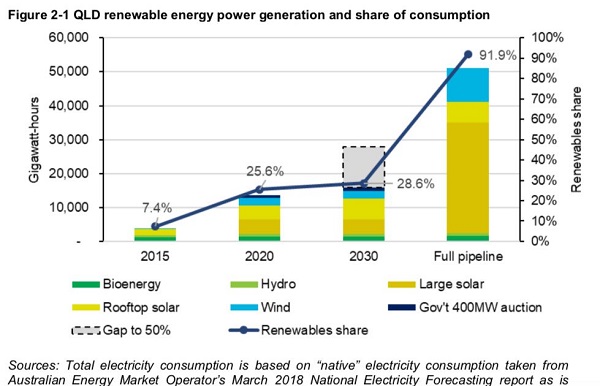
St Vincent de Paul reports that Queensland home electricity bills have fallen by about 7.5% in 2018.
Elsewhere Giles Parkinson says solar is starting to dig a hole in electricity prices during the middle of the day. The Australia Energy Market Operator predicts that within two years, every state grid in the country will experience minimum demand in the middle of the day, rather than at night:
- The AEMO prediction, made in its annual Electricity Statement of Opportunities, a 10-year forecast of demand and supply, notes that South Australia has been day-time minimums this since 2012, Tasmania experienced it last summer, and Queensland, Victoria and NSW could do the same as early as next year.
Flexible dispatchable power will be needed, not coal.
Then AEMO has also been talking about how the EV boom will reshape the way we use electricity. Here’s the possible future:
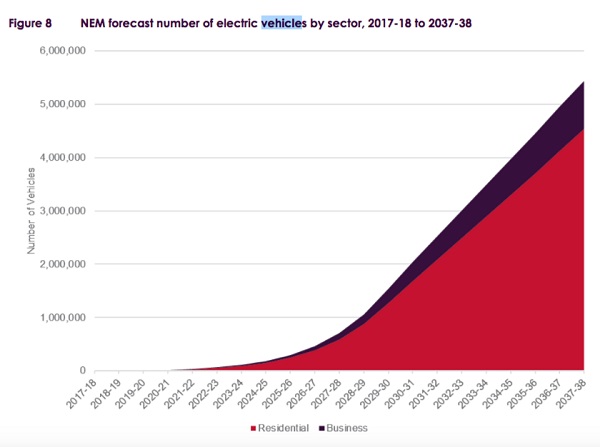
By 2027-28, for instance, it assumes 650,000 EVs on the road in Australia, which points to an average 65,000 EVs sold each year until then – although the uptake is not expected to be linear.
How and when they are charged will reshape how we use power.
Morrison is now talking about a royal commission into the energy sector. Mathew Stevens in the AFR suggests that on the evidence, maybe we need a royal commission to inquire into the government.
This is becoming embarrassing. Former chief scientist Ian Chubb told Patrician Karvelas that 84% of Australians want more investment in renewable energy, and 56% think our emissions reduction target should be 45% or greater.
Back in November 2013 I wrote about reconnecting climate change politics with reality. The suggestions there by Professor John Wiseman, Deputy Director of the Melbourne Sustainable Society Institute at the University of Melbourne look distinctly like what the Germans have done. In the land of OZ, however, climate politics has now moved firmly to an alternative reality.
ABC RNs Background Briefing addressed the Liberal Party crisis in the latest episode. From about 34:00 in the audio Judith Brett comments. She says climate change (denialism) has become an identity issue for the right in the Party. As soon as someone takes climate change seriously, the right start organising against them.
The National Party would struggle to produce a member who accepts human causation.
The prospects of bipartisanship on climate change policy in the foreseeable future are zero.
Just as Malcolm Turnbull was finally facing the music Annabel Crabb wrote a piece Australia’s recent climate change policy: A brief history of seven killings beginning with Turnbull being topped by one vote as Liberal leader in 2009, through the Rudd-Gillard imbroglio and ending with the prospective Turnbull termination, which became real.
We need another killing now, in an election. A recent Lowy Institute poll showed:
- In response to the survey’s questions on climate and energy, 59% of respondents agreed with the statement: “climate change is a serious and pressing problem. We should begin taking steps now even if this involves significant costs.” (Emphasis added)
It’s time to act, and it’s clear such action will have to be in spite of the Federal Liberals and Nationals, whether or not they occupy the treasury benches.
Update:
In yesterday’s RenewEconomy:
South Australia has always had high electricity prices because of poor coal resources and the need to use gas. With renewables prices have in fact gone down in the last decade:
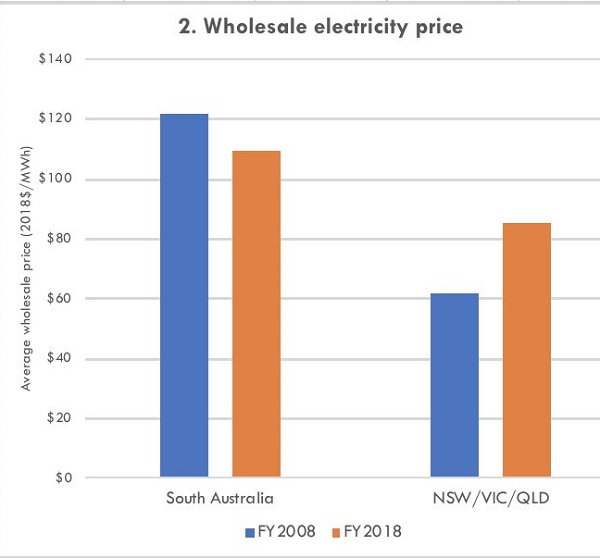
With 100% renewables by 2025 and an interconnector to New South Wales they could effectively turn off the gas.
A report by ClimateWorks looks at what Australia needs to do to reach zero emissions by 2050. This is doable, but in order to achieve this we would need approximately 70 per cent renewable generation in the electricity grid by 2030.
- A new report from Australian and international researchers suggests there is no prospect for a new coal generator in Australia, and even existing coal generators are going to be challenged by the falling costs of renewables and storage.
The report, “Implementing coal transitions: insights from case studies of major coal-consuming economies” has been produced by an international consortium, including French think tank IDDRI, and researchers from the Australian National University, among others.
It is the Australian conclusions that are the most striking, particularly in relation to the renewed political dialogue around the need to protect existing and encourage new investments in what the Coalition government is describing as “fair dinkum” “reliable”, “24-hour baseload” power. i.e. coal.
Frank Jotzo, from the ANU, has some sobering news. The point where new wind and solar, backed by energy storage become cheaper than operating old coal plants is not far away – a conclusion more or less confirmed by AGL, with its plans for Liddell.
(Emphasis added)The funding, and the number of projects it will support, underscore the rapidly growing interest in renewable hydrogen, as a low-carbon fuel source, a potentially valuable export commodity, and as a form of energy storage.
It follows a series of major reports – including from the CSIRO, ARENA, and Australia’s chief scientist, Alan Finkel – highlighting the potential of clean hydrogen, as “versatile energy carrier and feedstock” as Australia moves to decarbonise its economy.
There has been resistance on the part of the NEM rule maker, The Australian Energy Market Commission (AEMC), to allow demand response as a freely available tool to knock the top off demand spikes on the spot market. A new proposal has now been put up to use wholesale demand response (WDR) as a routine tool.
What damage will Angus Taylor do?
From the above, it is blindingly obvious that the transition to renewable energy is proceeding apace. It seems we now have a Federal energy minister who will contribute nothing positive. The question remains as to what damage he can do with that big axe David Rowe portrayed in his hands.
See also:
The die is cast – Turnbull chooses political power over the future of the planet and humanity

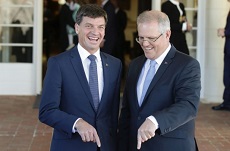
Brian, you say:
I reiterate:
Do you think your blog has sufficient reach to spread the word where it counts? I’m not trying to be rude – just asking what I think is pertinent, in reference to your statement: “It’s time to act…” Shouldn’t we all be acting to initiate effective change? Or do you mean something else?
Some of us are making our voices heard this Saturday.
Find Australian events down the left hand side – it’s not set out as well as it could be 🙁
Meanwhile, back in the unreal world
GM, by what right do you demand that Brian takes different action?
Each of us is entitled to choose what action we take, and the manner in which we take it.
Cheerio
Ambi, don’t worry I won’t take the slightest bit of notice of GM’s exhortations and it doesn’t bother me.
I’m flat out participating in these threads as well as writing stuff. I’d be interested in GM answering one question – do you think the stuff you read here is intrinsically worth reading?
You can never tell what difference something is going to make. Once when I worked in the education department someone hailed me in the street. He said that years before I had suggested such and such. He had taken my gratuitous advice and he said it changed his life. He just wanted to thank me.
I was a bit shocked. It sounded as though it could have been me, but I had no memory of it or him.
Every day 20 to 30 strangers visit the blog by searches and referred links and leave no trace other than the statistic.
I enjoy writing, and don’t need much encouragement. I have a busy life otherwise and don’t have time or head-space to do systematic lobbying.
GM can walk in his shoes and I’ll walk in mine.
As to where it counts I rather thought the point of the post was that the Coalsheviks have to be defeated in the ballot box, or simply ignored.
Others might find what I write useful to them, but that is up to them.
What I write is in part a working out of what I think about things. I’m not expecting to start a revolution.
St Vincent de Paul reports that Queensland home electricity bills have fallen by about 7.5% in 2018.
Their reports on other states can be accessed here.
Excellent summary, Brian. Reason in the face of ball busting political stupidity.
I have been immersed in the US disaster, …… and taking possession of our yacht (a 2001 Southerly 135) in France to be named Aurora Leigh and flagged in Jersey.
For me your take away comment is that the German government looks to science for policy guidence. Until that becomes Australia’s model we will continue to flounder as a low IQ nation with an increasing prospect for being annexed by China as global political turmoil increases due to the impacts of Global Warming.
However, in the mean time, all real action on Climate Change will continue to be driven from the bottom up. My current project in that direction is a recirculating shower that enables one to have a half hour shower (my usual) with just 12 litres of water. I’m designing it for boats but it will have application in many places in the future.
BilB, bottom up it is, at least until the next election.
I think Federal Labor now needs to look at its policies taking into account that bipartisanship will be impossible and therefore irrelevant. This gives them the freedom to look for the best way of doing things instead of NEG which was considered probably the fourth best of recent attempts by the LNP.
I’ve done a major update to the post, as below:
Update:
In yesterday’s RenewEconomy:
South Australia has always had high electricity prices because of poor coal resources and the need to use gas. With renewables prices have in fact gone down in the last decade:
With 100% renewables by 2025 and an interconnector to New South Wales they could effectively turn off the gas.
A report by ClimateWorks looks at what Australia needs to do to reach zero emissions by 2050. This is doable, but in order to achieve this we would need approximately 70 per cent renewable generation in the electricity grid by 2030.
A new report from Australian and international researchers suggests there is no prospect for a new coal generator in Australia, and even existing coal generators are going to be challenged by the falling costs of renewables and storage.
The report, “Implementing coal transitions: insights from case studies of major coal-consuming economies” has been produced by an international consortium, including French think tank IDDRI, and researchers from the Australian National University, among others.
It is the Australian conclusions that are the most striking, particularly in relation to the renewed political dialogue around the need to protect existing and encourage new investments in what the Coalition government is describing as “fair dinkum” “reliable”, “24-hour baseload” power. i.e. coal.
Frank Jotzo, from the ANU, has some sobering news. The point where new wind and solar, backed by energy storage become cheaper than operating old coal plants is not far away – a conclusion more or less confirmed by AGL, with its plans for Liddell.
(Emphasis added)The funding, and the number of projects it will support, underscore the rapidly growing interest in renewable hydrogen, as a low-carbon fuel source, a potentially valuable export commodity, and as a form of energy storage.
It follows a series of major reports – including from the CSIRO, ARENA, and Australia’s chief scientist, Alan Finkel – highlighting the potential of clean hydrogen, as “versatile energy carrier and feedstock” as Australia moves to decarbonise its economy.
There has been resistance on the part of the NEM rule maker, The Australian Energy Market Commission (AEMC), to allow demand response as a freely available tool to knock the top off demand spikes on the spot market. A new proposal has now been put up to use wholesale demand response (WDR) as a routine tool.
What damage will Angus Taylor do?
From the above, it is blindingly obvious that the transition to renewable energy is proceeding apace. It seems we now have a Federal energy minister who will contribute nothing positive. The question remains as to what damage he can do with that big axe David Rowe portrayed in his hands.
Ambigulous (Re: SEPTEMBER 6, 2018 AT 6:07 PM):
There was no “demand” – I was asking some questions directed to Brian. Why do you feel the need to answer questions directed to others? Are you feeling a little uncomfortable? Or is that faux outrage to distract from the inconvenient/uncomfortable questions?
I refer you to the questions I asked Graham Bell:
I’m engaging with decision-makers. What are you doing?
You still haven’t answered my question. I suspect my question is inconvenient for you, as your earlier response seems to me to be an obfuscation. Presumably you’ve read the information on the CP website? Are you doing anything beneficial with it? Or is it all top secret/hush-hush?
Brian (Re: SEPTEMBER 6, 2018 AT 10:29 PM):
But “others” have to know what you write is here at CP – hence my question about CP’s reach. And “others” need to make the effort to read your posts. I only came across CP by accident.
People need to be adequately informed. If they rely on false information/propaganda (or are too lazy to care) then they may vote for the wrong candidates, to the detriment of the country/state. That’s the risk on any issue.
In the SMH, there’s Peter Hannam’s article headlined ‘Overwhelming’ economics favour accelerating shift from coal, reports say. It refers to Lord Nicholas Stern’s report and ANU’s report by Frank Jotzo and Salim Mazouz. Hopefully, that will gain wider attention.
Don’t assume the decision-makers are adequately briefed – example: look at what Angus Taylor said earlier this week to Alan Jones.
GM
I will not answer your demands.
I have mentioned in the past that we increased our rooftop solar pv capacity from 1kW to 5kW late last year. But really, that’s my business. And the discussions I have with friends, family, and local groups here are also my business.
When I contact my Federal MP, it will be on my terms and will not be retailed here*.
I wasn’t “answering” your questions to Brian. I can’t speak for him; I don’t presume to. Likewise, would you mind not prescribing to readers or posters here, the actions (or style of actions) they should take?
Yes, I think it’s rude.
My long and boring comments on social change were not intended to obfuscate any question: how to change minds, how to usher in new, renewable technologies are vital areas (but only in my opinion, of course).
You have your opinions and methods; I have mine.
Good luck!!
* I will break my rule: the only time I have met my local MHR I talked to the MP about electric currents, voltage, and small scale solar PV panels. But it was a private conversation.
Geoff, if I had more time I would spend it on promoting my blog.
Thanks for the link to Hannan at the SMH. I don’t have a sub, so scanning the site chews up my allocated free reads.
I was about to write something about coal power.
Geoff, I suspect that giving information to coalsheviks in the Liberal and National Parties is a waste of time. But I guess someone has to do it, lest silence be taken as assent.
Brian (Re: SEPTEMBER 7, 2018 AT 10:52 PM):
I’ve phoned offices of a few coalsheviks to draw attention to data that I thought they should be aware of. The conversations with the staffers have given me the impression the staffers at the very least are not well briefed. Some have thanked me for the information and said they will pass it on – whether that’s just being polite is debatable (for some) – but I think it would be regrettable if there was no engagement with them. There’s always a risk that they live in an information bubble, excluding data that is inconvenient – I’m attempting to burst that bubble with compelling facts.
On 15 June 2018, I rang Craig Kelly MP Canberra office (phone 02 6277 4366), in response to Craig Kelly’s on-air interview earlier that day on Radio 2GB with Ray Hadley, to draw attention to:
1. The NSW Parliament Select Committee inquiry on Electricity Supply, Demand and Prices in NSW, and in particular the sworn testimony by Professor Andrew Blakers at the 21 Feb 2018 public hearing, where he says, on page 53 of the Committee Hansard transcript:
“If you want cheap electricity you push renewables as hard as you can.”;
2. The YouTube video titled 2017 CURF Annual Forum – Andrew Blakers keynote – duration 38 minutes;
3. The Boom and Bust 2018 report, with particular reference to Figure 5: Coal Power Capacity in Pre-Construction and Construction Jan 2016 to Jan 2018, where it indicates the declining GW capacity from 2016 to 2018 – i.e. a substantial quantity of coal-fired generator projects were being cancelled during this period.
I think it’s more than a coincidence that in the following week The Monash Forum released its first Coal “Factsheet 1”. It’s clear that The Monash Forum ignored most of the inconvenient data, but it clearly endorsed the CoalSwarm data referenced in its “Factsheet 1”. They can’t now denigrate the latest data from CoalSwarm (to July 2018) without risk of being accused of blatant cherry-picking – but so far as I can tell to date, they aren’t highlighting the latest (less convenient for their narrative) data either.
My point is that you cannot assume these people are well briefed – clearly they demonstrate they aren’t. My experience suggests by engaging with them, perhaps there’s a chance that something better can come out of it. But there’s Buckley’s if you don’t engage.
Brian (Re: SEPTEMBER 7, 2018 AT 10:40 PM):
The SMH article begins with:
The article refers to the latest New Climate Economy report, co-authored by among others, Lord Nicholas Stern.
And it refers to the separate Coal Transitions report, by researchers including Frank Jotzo and Salim Mazouz from the Australian National University.
New post Coal power fading fast deals with both reports, though not comprehensively, and more.
This morning, ScoMo was telling Radio 2GB’s broadcaster Alan Jones on-air:
Does anyone know where ScoMo gets these figures from? I suspect they are bogus.
Good question. He repeated it on TV tonight.
All I could find was this – Coalition’s national energy guarantee predicted to drive up power prices:
On Friday 20 July Reputex modelling showed;
I think we are seeing information-free government.
Brian (Re: SEPTEMBER 11, 2018 AT 10:51 PM):
I think you’re being too kind. I suspect ScoMo is telling outright lies (re my comment at SEPTEMBER 11, 2018 AT 4:54 PM).
I ask:
Why don’t the media challenge ScoMo on his numbers?
Why don’t the media (at the very least) ask ScoMo where he gets those numbers from?
Let me offer a guess:
because the majority of journalists are lacking in some numeracy skills and/or have not done the background research that you, Geoff (along with Brian, BilB, John), have made the effort to do.
Not sure who said it first: “The Canberra Press Corps suffers from delusions of adequacy”.
Here is an issue that has bedeviled Aussie governments for more than a dozen years…. and most of the journalists still aren’t up to speed on the area…